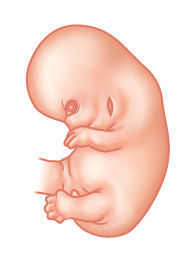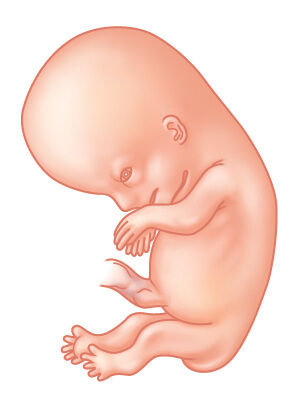9 weeks and 7 days pregnant

The bones of the front of the skull are starting to grow over the baby’s forehead and harden from cartilage to bone. The forehead is still very prominent and the top of the head still very flexible to accommodate the baby’s rapidly developing brain.
The placenta is now fully formed and mature enough to start supplying all your baby’s needs, although it will continue to grow.
This is a milestone in your baby’s development as the placenta takes over from the yolk sac to provide your baby with nutrients. Just like your baby, the placenta has needed to grow and develop a circulation to support the ever-increasing demands that are being placed on it.
One week after fertilization, the placenta formed a distinct inner and outer layer of cells that gradually penetrated the lining of the uterus, with finger-like fronds. You may have noticed a very slight bleed at this implantation stage. More and more fronds spread out into the lining of the uterus, which itself undergoes a transformation process that enables each frond or villus to be bathed by small pools of maternal blood, enabling oxygen and nutrient transfer to take place.
Up until now, this blood flow has been limited by plugs of tissue, but at this stage of pregnancy these plugs begin to disappear. This means the placenta is sufficiently developed to withstand the pressure of maternal blood on each delicate villous. Villi will continue to branch out until around 30 weeks of pregnancy.
Staying hydrated is essential throughout pregnancy.A good tip is to eat fruit that is high in water. Water contained in fruit is easily absorbed into the body, because fruit contains natural sugars that draw water into the bloodstream. Melons – watermelon, cantaloupe, and honeydew – are naturally high in water. In addition, their mellow and less acidic nature makes them well tolerated in pregnancy.
In addition to helping you stay hydrated, melons supply you with extra folate, as well as other vitamins and nutrients. Try combining melons with cottage cheese or yogurt, sprinkled with granola, for a light meal, or blend them into a nutritious smoothie.

What is meant by rhesus negative?
Red blood carries a positive or negative rhesus factor (Rh-factor). Problems arise if an Rh-negative woman carries an Rh-positive baby who has inherited the Rh-positive status from the father. If the mother’s blood comes into contact with the baby’s during delivery, she may produce antibodies against it.
This may cause problems in subsequent pregnancies when a mother’s antibodies attack the cells of another Rh-positive baby, which can lead to severe anaemia and heart failure in the baby after the birth. You will be given injections to combat this.
After 10 weeks your baby’s crown to rump length is 3cm (1.2in).

9 weeks

10 weeks
Be the first to support
Be the first to share
Comment (0)
Related Blogs & Vlogs
No related events found.
Loading more...